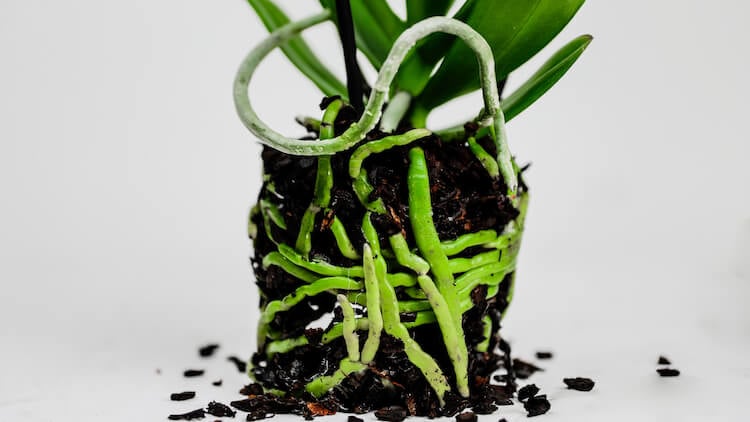
Your orchid's roots perform two functions critical for the successful growth of the plant. First, they hold your plant in place as it grows. Typically, in nature orchids live on tree branches high above the tropical forest floor and use their roots to anchor themselves onto branches. When planted in pots, the roots can sometimes attach to the pot and be somewhat difficult to remove.
The second function of your orchid’s roots is to provide it with water and nutrients. Orchid roots are a great indicator of your plants' health and can give you a lot of useful information.
Like other epiphyte orchids, the roots of Phalaenopsis roots are covered with a spongy epidural tissue called “velamen.” Just a few cells thick, velamen helps orchid roots absorb water and nitrogen from the air. It also provides the stickiness that allows epiphytic orchids to cling to tree branches. When Phalaenopsis orchid roots are healthy, velamen is silvery-white, round and plump. As water is absorbed, velamen turns green, returning to its natural whitish color several hours after watering. Velamen covers the length of each root except for the tip, which, when healthy, should be glossy green or reddish and pointed.
Like us, orchids get hungry and thirsty and will let you know that through their roots.
When our orchid’s roots are a lush, green color, they’ve had just the right amount of water. On the other hand, if, they are a shade of grayish white, they’d probably love some more water. If you notice your orchid’s roots look completely white or gray before they are due for their next watering, it’s a good idea to start giving your orchid 4 ice cubes instead of 3. On average, though, we recommend watering your plant with 3 ice cubes once per week.
If your orchid’s soil is a little too moist, you might notice that its roots are growing more outside the pot. This is a-okay, though. These are called air roots, and they present no harm to the orchid. They are helpful in absorbing moisture and carbon dioxide from the air.
While they may not be the prettiest to look at, don’t just cut them off! Unlike other plants that attach themselves to trees, Phalaenopsis orchids are not parasitic. Instead, they use their roots to absorb nutrients from the air, absorbing moisture and obtaining carbon dioxide they need to thrive.
You should not remove healthy air roots. There’s a good chance you can harm your plant. You could even introduce a dangerous virus.
In homes with low humidity, air roots can turn yellow and shrivel. If this occurs, wait until your orchid stops blooming, and then use a sterile knife or scissors to cut away the shriveled roots.
There’s also the chance your plant is outgrowing your pot. If you need to repot your plant, wait until the blooms fall off and then go for it.
Tea soaks: Tea may be partly composed of nitrogen, but that does not mean that the nitrogen in the tea is available for root uptake when used to water orchids. It is far more effective to use a synthetic or organic orchid fertilizer researched and tested for plant use.
Hydrogen peroxide: It can kill and inhibit microorganisms, but not at the rate that is healthy for your orchid’s roots. Recent research has shown that hydrogen peroxide has the potential to harm more than help orchid root health, causing root decay rather than encouraging root growth.
Cinnamon: While cinnamon does have some antifungal and antibacterial benefits, it can also cause other issues if applied to your orchid’s roots. In fact, cinnamon causes the dehydration of living plant tissue. There are some uses for cinnamon in plant care, just not in orchid roots. Applying cinnamon to roots can prevent water uptake and cause root malfunction.
Make sure you choose a light potting material, such as peat moss, sphagnum moss, or bark chips. A light potting material has sufficient water holding ability to enable the orchid to stay healthy and provides enough aeration for the roots.
If the leaves of your orchid are becoming a little crinkled or its pods are shrinking, it means that it needs watering. It is important to know that an orchid is better off being too dry than too wet. Overwatering can result in root rot.
Keep watering your orchid until the potting material is completely moist. The quantity of water and the frequency of watering may vary depending on the potting material used and the temperature and humidity in the growing area.
If you want more information about root health, download our helpful guide by clicking here.

Copyright Just Add Ice® Orchids 2023